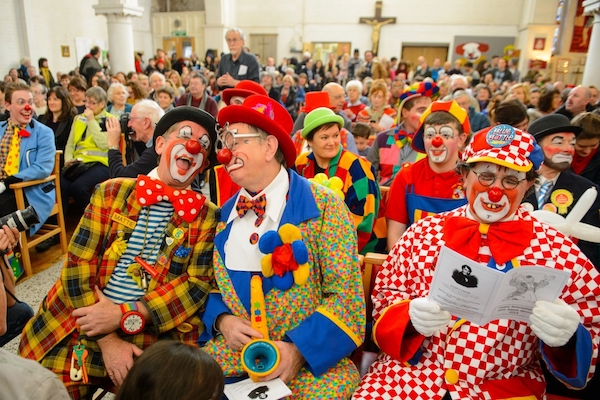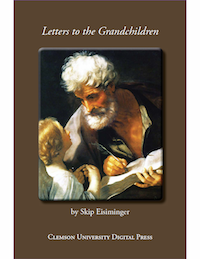Pieing It Forward: Clowning
“In March of 2017 as I write, many Americans like myself are bewildered by a ‘jester’ who has seized the ‘throne,’ and it remains to be seen how the leveling will fare under his good-cop-bad-cop rule. Seeking some comic relief after Donald Trump’s election, I suggested to my wife that we ‘send in the clowns,’ but she reminded me, ‘Don’t bother. They’re already here.’” —Skip Eisiminger
Skip the B.S.
By Skip Eisiminger

CLEMSON South Carolina—(Weekly Hubris)—April 2017——In the early 1950s, my parents took my sisters and me to see the Ringling Brothers’ Circus, but the only thing I recall, aside from going, is Emmett Kelly’s poignant conclusion to “The Greatest Show on Earth.”
I. The clown should play his role as close to tragedy as circumstances allow.”—Anonymous
Kelly (1898-1979) was a sad-faced clown who carried a broom so that when the elephants and horses were led off stage, he could “sweep” the last stubborn pool of light into the darkness. I recall asking my father why “Weary Willie” looked so sad, and he told me of the circus fire in Hartford, Connecticut that had taken 168 lives less than a decade earlier.
Many years later, I ran across the famed photograph of Kelly carrying a bucket of water in a desperate but futile attempt to extinguish the fire. Though thousands escaped under the tent flaps, the “tears of the clown” suddenly made sense. After the horrors Kelly had seen, how could he wear any other expression as he went about the business of clowning?
To the best of my knowledge, Kelly never performed as a rodeo clown, but he operated under the same premise: “Those who laugh, last.” Well, at least they help the bull riders last. Like physician and clown Dr. “Patch” Adams, Kelly lengthened the lives of millions by kindling laughter.

II. “Some people say my humor focuses too much on [Jewish] stereotypes. It doesn’t. It focuses on facts.” —Sarah Silverman
Cartoonists who accept the challenge to mock one of their cousins must find a way to make shopworn stage properties like top hats and walking sticks fresh and funny again. This is the implicit challenge driving the following New Yorker cartoons published over the last 16 years:
- a cream-pie deliveryman, arm raised, standing at a clown’s front door.
- a balloon dog clawing a clown’s furniture.
- a clown crossing the desert begging for seltzer.
- a clown at a urinal relieving his lapel flower.
- a shoe salesman bringing a three-foot long shoebox to a clown.
- 30 clowns unloading five caskets from a hearse.
Would a clown cradling a live puppy be as funny as one leading a helium-balloon dog? I doubt it. Literature may be “news that stays news,” but clowning like cartooning that’s anchored in the past grows rusty.
III “Who hires a clown anymore to entertain children at a birthday party?”—Anonymous
Sadly, the profession of clowning, once venerated, has lost its innocence. The decline began in the 1980s when police revealed that John Wayne Gacy, who killed 33 people and buried them in the crawl space beneath his house, often baited his hook wearing a clown costume. Since then, Stephen King’s demonic clown Pennywise, the horror hip-hop band Insane Clown Posse, and the “stranger danger” movement have continued the downward push that may soon end the clown tradition despite the fact that Americans have never been safer. As of 2016, membership in Clowns International had fallen from several thousand to just over a hundred.
IV “I remain one thing, and one thing only, and that is a clown. It places me on a far higher plane than any politician. —Charlie Chaplin
From Punch to Petrushka, from Chou to Hanswurst, the jester, both in and out of the royal court, has been a subversive but largely positive force for “democracy.” It’s difficult to evaluate the leveling work of a nameless dwarf jester employed to amuse the Egyptian pharaoh, c. 2500 BC, because if there ever was a papyrus record, it’s been lost. But a jester named Yu Sze, who convinced the Chinese emperor that the Great Wall did not need a coat of paint, is honored by his countrymen to this day. One source says that Sze’s wisecrack about making the Mongols pay for the paint job convulsed the Forbidden City, but that may be fake news.
Many a jester has been executed because any naked suggestion of democracy, minority rights, or sharing the wealth was ridiculed for millennia. Thus, the designated comic reliever was always skating on thin ice setting the court’s norms by implication: new courtiers learned to behave, in part, by observing the parallel “Bizarro World” approved by the king. Despite its value to the court, jesting was a lonely and often dangerous profession.

In March of 2017 as I write, many Americans like myself are bewildered by a “jester” who has seized the “throne,” and it remains to be seen how the leveling will fare under his good-cop-bad-cop rule. Seeking some comic relief after Donald Trump’s election, I suggested to my wife that we “send in the clowns,” but she reminded me, “Don’t bother. They’re already here.” Fortunately, late-night television remains a force opposed to demagoguery where swamps are regularly drained for the commonweal, but Stephen Colbert and his peers, like generations of clowns before them, do not command an army, which is as it should be.
V “Joseph Grimaldi, the 19th-century angel of clowning, said that after being ‘grim all day’ he was ready to jest at night.” —Anonymous
It doesn’t take much to convince a child growing up in “Tornado Alley” that a carrousel is a “horse tornado.” As they say in Brazil, “The dog bitten by the snake fears the sausage” because first impressions are often indelible. However, if the dog has been fed sausages all its life, it’s not as likely to turn away from his favorite food after being snake bit.
Thus, the child who sees a clown’s painted smile before watching a careless video of It (the film in which King’s Pennywise made his debut) is not as likely to develop a clown phobia. One survey showed that 12 percent of Americans are coulrophobic, literally “afraid of people on stilts,” one of the earliest clown attributes. But if, for centuries, the clown’s painted face led the audience to smile, there’s every reason to believe, with a little self-restraint, the world can learn to love clowns again.

VI “We are all fools for Christ.” —I Corinthians 4:10
Since Trump’s election, I’ve been placing a lot more credence in the observation that humans are God’s clowns. And by “God’s clowns,” I don’t mean the insulting reference to the differently abled; I’m referring to Homo sapiens. Perhaps taking a hint from Morris West’s novel The Clowns of God (1981), cartoonists have been using a heavenly perspective to vary the comic landscape for several decades. From this superior position, God has tossed a variety of comic props into the circus tent, everything from chocolate to alcohol, to see how His top-of-the-food-chain stars would respond. I’m sure He’s been amused.
Had Jesus, Mohammad, or Buddha worn a flowered straw hat and walked on stilts while juggling stones, I doubt there would have been a culture of orthodox believers who placed people in the stocks because they laughed on Sunday. Many, including me, feel that if Jesus had played the fool but once, we could laugh more freely at life’s absurdities. As it is, the few clowns who are left have formed “Clowns Lives Matter” to defend themselves from assault.
Frankly, to die laughing has always seemed like one of the better ways to shake off this mortal coil, aided, like Chuckles the Clown, by a “little seltzer down the pants.”

To order copies of Skip Eisiminger’s Letters to the Grandchildren (Clemson University Digital Press), click on the book cover below or contact: Center for Electronic and Digital Publishing, Strode Tower, Box 340522, Clemson SC 29634-0522.



